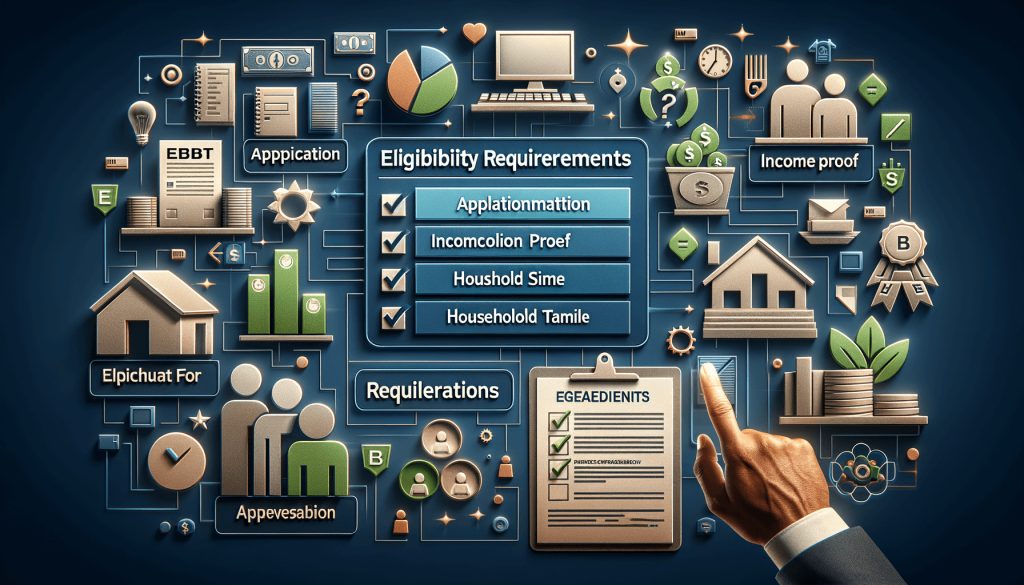
By Ethan Brooks November 2, 2024
Understanding EBT payment processing is crucial for businesses that wish to accept Electronic Benefits Transfer (EBT) cards, which are used by recipients of government assistance programs like the Supplemental Nutrition Assistance Program (SNAP). To begin with, it is essential to comprehend the key requirements and eligibility criteria that businesses must meet to get approved for EBT payment processing. This understanding not only facilitates a smoother application process but also ensures compliance with federal and state regulations.
First and foremost, businesses must determine their eligibility to accept EBT payments. Typically, retailers that sell food items are eligible, as EBT cards are primarily used for purchasing groceries. However, not all food retailers automatically qualify. The United States Department of Agriculture (USDA) has specific criteria that businesses must meet. For instance, a store must offer a variety of staple foods across different categories such as dairy, bread, cereals, fruits, vegetables, and meats. Alternatively, a business can qualify if more than 50% of its total gross sales come from the sale of eligible staple foods.
Once eligibility is established, the next step involves understanding the application process. Retailers must apply through the USDA’s Food and Nutrition Service (FNS). This process requires the submission of several documents, including a completed application form, a copy of the business license, and tax identification information. Additionally, businesses must provide details about their inventory and sales, which help the USDA assess whether the store meets the necessary criteria.
Moreover, it is important for businesses to be aware of the technical requirements for EBT payment processing. This includes having the appropriate point-of-sale (POS) equipment that can process EBT transactions. Many modern POS systems are equipped to handle EBT payments, but it is crucial to verify this capability with the equipment provider. Furthermore, businesses must ensure that their internet connection is reliable, as EBT transactions are processed online.
In addition to technical requirements, businesses must also adhere to specific operational guidelines. For example, retailers are prohibited from charging sales tax on EBT purchases and must ensure that EBT transactions are processed separately from other payment methods. It is also important for businesses to train their staff on how to handle EBT transactions correctly, as this can prevent errors and ensure a smooth checkout experience for customers.
Furthermore, understanding the compliance and reporting obligations is vital. Businesses must maintain accurate records of all EBT transactions and be prepared for potential audits by the USDA. Non-compliance with EBT regulations can result in penalties or disqualification from the program, so it is imperative for businesses to stay informed about any changes in the rules and regulations governing EBT payment processing.
Eligibility Requirements for EBT Payment Processing

To be eligible for EBT payment processing, individuals or households must meet specific criteria set by the government. These requirements may vary depending on the state, but generally, eligibility is determined based on income, assets, and household size. It is crucial to understand these requirements before applying for EBT payment processing to ensure a smooth application process.
Step-by-Step Guide to Applying for EBT Payment Processing
Applying for EBT payment processing involves several steps that need to be followed carefully. This step-by-step guide will help you navigate the application process smoothly:
- Research: Begin by researching the EBT program in your state. Understand the specific eligibility requirements, benefits, and limitations associated with the program.
- Gather Required Information: Collect all the necessary information and documents required for the application process. This may include proof of identity, income verification, and residency documentation.
- Locate the Application: Find the appropriate application form for EBT payment processing in your state. This can usually be found on the official website of your state’s Department of Social Services or equivalent agency.
- Complete the Application: Fill out the application form accurately and provide all the required information. Double-check for any errors or missing details before submitting.
- Submit the Application: Submit the completed application form either online, by mail, or in person, as per the instructions provided. Ensure that you meet the deadline for submission.
- Attend an Interview (if required): Some states may require an interview as part of the application process. If notified, make sure to attend the interview and provide any additional information or documentation requested.
- Await Approval: After submitting your application, it may take some time for the review process to be completed. Be patient and wait for the decision.
- Receive EBT Card: If approved, you will receive an EBT card in the mail. Activate the card as instructed and familiarize yourself with its usage guidelines.
Required Documentation for EBT Payment Processing Application
When applying for EBT payment processing, certain documents are typically required to verify your eligibility. The specific documentation may vary by state, but commonly requested documents include:
- Proof of Identity: This can be a driver’s license, passport, or any other government-issued identification document.
- Proof of Residency: Provide documents such as utility bills, rental agreements, or mortgage statements that establish your current address.
- Social Security Number: You will need to provide your Social Security number or proof of application for one.
- Income Verification: Submit documents such as pay stubs, tax returns, or a letter from your employer to verify your income.
- Household Composition: Provide information about the individuals living in your household, including their names, ages, and relationships.
- Immigration Status (if applicable): If you are a non-U.S. citizen, you may need to provide documentation related to your immigration status.
- Child Support Payments (if applicable): If you receive or pay child support, you may need to provide documentation related to these payments.
- Disability Verification (if applicable): If you or a household member has a disability, you may need to provide documentation to support your claim.
- Bank Statements: Some states may require recent bank statements to verify your financial situation.
- Any Other Relevant Documentation: Depending on your circumstances, additional documentation may be required. Check with your state’s EBT program for specific requirements.
Common Mistakes to Avoid When Applying for EBT Payment Processing

When applying for EBT payment processing, it is essential to avoid common mistakes that can delay or jeopardize your application. Here are some mistakes to avoid:
- Incomplete or Inaccurate Information: Ensure that all the information provided on the application form is accurate and complete. Double-check for errors before submitting.
- Missing Documentation: Make sure to include all the required documentation with your application. Missing documents can lead to delays or rejection.
- Failure to Meet Deadlines: Be aware of the application submission deadline and submit your application well in advance to avoid missing it.
- Lack of Communication: If you receive any communication from the EBT program, respond promptly and provide any additional information or documentation requested.
- Failure to Update Information: If there are any changes in your circumstances, such as a change in income or household composition, inform the EBT program immediately.
- Providing False Information: Providing false information on your application is illegal and can result in severe consequences. Be honest and transparent throughout the process.
- Not Seeking Assistance: If you are unsure about any aspect of the application process, seek assistance from the EBT program or other relevant organizations. They can provide guidance and support.
- Ignoring Review Process Updates: Stay informed about the progress of your application. If there are any updates or requests for additional information, respond promptly.
- Not Keeping Copies: Make copies of all the documents you submit with your application. This will help you in case any documents are lost or misplaced.
- Giving Up: If your application is initially denied, you have the right to appeal the decision. Seek assistance and explore your options before giving up.
Understanding the EBT Payment Processing Review Process
Once you have submitted your application for EBT payment processing, it goes through a review process to determine your eligibility. The review process typically involves the following steps:
- Application Verification: The EBT program reviews your application to ensure that all the required information and documentation are provided.
- Eligibility Determination: The program assesses your eligibility based on the information provided, including income, assets, and household composition.
- Income Calculation: Your income is evaluated to determine if it falls within the program’s income limits. This may involve reviewing pay stubs, tax returns, or other income verification documents.
- Asset Evaluation: The program may assess your assets, such as bank accounts or property, to determine if they exceed the program’s asset limits.
- Review of Supporting Documentation: The program reviews all the supporting documentation provided to verify the accuracy of the information provided.
- Interview (if required): If an interview is part of the application process, it will be conducted to gather additional information or clarify any discrepancies.
- Decision Notification: Once the review process is complete, you will receive a notification informing you of the decision. If approved, you will receive instructions on how to access and use your benefits.
Tips for a Successful EBT Payment Processing Application
To increase your chances of a successful EBT payment processing application, consider the following tips:
- Research Eligibility Requirements: Familiarize yourself with the eligibility requirements specific to your state. This will help you understand if you meet the criteria and what documentation you need to provide.
- Gather Documentation in Advance: Collect all the required documentation before starting the application process. This will ensure a smoother and more efficient application submission.
- Seek Assistance if Needed: If you are unsure about any aspect of the application process, reach out to the EBT program or other relevant organizations for guidance and support.
- Be Accurate and Complete: Provide accurate and complete information on the application form. Double-check for errors or missing details before submitting.
- Keep Copies of Documents: Make copies of all the documents you submit with your application. This will help you in case any documents are lost or misplaced.
- Follow Instructions Carefully: Read and follow all the instructions provided with the application form. Failure to comply with instructions may result in delays or rejection.
- Be Responsive: If you receive any communication from the EBT program, respond promptly and provide any additional information or documentation requested.
- Stay Informed: Keep track of the progress of your application and stay informed about any updates or requests for additional information.
- Maintain Open Communication: If there are any changes in your circumstances, such as a change in income or household composition, inform the EBT program immediately.
- Seek Appeals if Necessary: If your application is initially denied, explore your options for appeals. Seek assistance and gather any additional information that may strengthen your case.
Common Challenges and Solutions in EBT Payment Processing Approval

Navigating the approval process for EBT payment processing can be a complex endeavor, often fraught with challenges that businesses must overcome to successfully accept Electronic Benefits Transfer (EBT) payments. Understanding these common challenges and their solutions is crucial for businesses aiming to expand their payment options and cater to a broader customer base. One of the primary challenges businesses face is meeting the stringent eligibility requirements set by the government.
These requirements are designed to ensure that only qualified retailers can accept EBT payments, which are primarily used for purchasing food and other essential items. To address this, businesses must thoroughly review the eligibility criteria and ensure they meet all necessary conditions before applying. This often involves providing detailed documentation and demonstrating compliance with specific regulations.
Another significant challenge is the complexity of the application process itself. The application for EBT payment processing can be daunting, with numerous forms and detailed information required. Businesses may find themselves overwhelmed by the paperwork and the need for precise data entry.
To mitigate this, it is advisable for businesses to seek assistance from professionals who specialize in EBT applications or to utilize resources provided by the government that offer guidance on completing the application accurately. Additionally, maintaining accurate and up-to-date records is essential, as any discrepancies can lead to delays or denial of the application.
Technical challenges also pose a significant hurdle in the approval process. Implementing the necessary technology to process EBT payments requires an understanding of the specific equipment and software needed. Businesses must ensure that their point-of-sale systems are compatible with EBT transactions and that staff are adequately trained to handle these transactions. Partnering with a reliable payment processor that offers EBT services can simplify this process, as they often provide the necessary technology and support to ensure seamless integration.
Furthermore, businesses may encounter challenges related to compliance with ongoing regulations and audits. Once approved, retailers must adhere to strict guidelines to maintain their ability to accept EBT payments. This includes regular audits and compliance checks to ensure that the business continues to meet all requirements. To address this, businesses should establish robust internal processes for monitoring compliance and be prepared for audits by maintaining comprehensive records of all EBT transactions.
In addition to these challenges, businesses must also consider the financial implications of accepting EBT payments. While offering EBT can attract a wider customer base, it may also involve additional costs, such as transaction fees and equipment expenses. Businesses should conduct a thorough cost-benefit analysis to determine whether the potential increase in sales justifies these expenses. Exploring options for financial assistance or grants specifically designed for businesses implementing EBT systems can also be beneficial.
Frequently Asked Questions
Q1. What is EBT payment processing?
EBT payment processing is a system that allows eligible individuals and families to access government assistance programs such as SNAP and TANF through an electronic card.
Q2. How do I know if I am eligible for EBT payment processing?
Eligibility for EBT payment processing is determined based on income, assets, and household size. Specific eligibility requirements may vary by state.
Q3. How long does it take to get approved for EBT payment processing?
The approval process can vary depending on the state and the volume of applications. It may take a few weeks to a couple of months to receive a decision.
Q4. Can I use my EBT card to purchase non-food items?
EBT cards can typically be used to purchase eligible food items. However, restrictions may apply to certain items such as alcohol, tobacco, and hot prepared foods.
Q5. Can I use my EBT card in other states?
Yes, EBT cards can generally be used in other states. However, it is essential to check with the specific state’s EBT program for any restrictions or limitations.
Conclusion
EBT payment processing plays a crucial role in providing essential assistance to eligible individuals and families. By understanding the eligibility requirements, following the step-by-step application process, and avoiding common mistakes, you can increase your chances of getting approved for EBT payment processing.
Remember to gather all the required documentation, provide accurate information, and stay informed throughout the review process. By maximizing the benefits of EBT payment processing, you can ensure access to nutritious food and other necessities for yourself and your family.